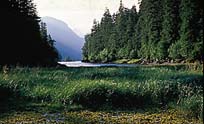|
|
The first commercial enterprise in
North America was a sawmill. Established in the Virginia territory in
1607, it set the tone for the European colonizers' treatment of the
forests in their new home—cut them down.
And so they did, razing most of the eastern hardwood forests by 1900 before moving west, to the softwood forests of the Rockies, California, the Pacific Northwest, and Alaska. The rapid clearing of the American forest brought alarm as early as the nineteenth century, and was a leading reason for the creation of the country's first conservation organizations. Today, Americans own 191 million acres of national forest in 156 separate forests in 45 states, Puerto Rico, and the Virgin Islands. This is twice the size of the national park system or the national wildlife refuge system. Three times as many people visit national forests as national parks, and the forests provide habitat for more rare species than refuges do. Hundreds of communities get their drinking water from national forest streams. Most forest land in the US is in private ownership, but the few remaining stands of virgin forest are virtually all on public lands. Even so, the national forests—the people, plants, and animals who rely
on them for recreation, livelihood, and habitat—increasingly threatened by
logging and related activities. More than 50 percent of the roughly 190
million acres of national forest land is already open to logging, mining,
and other extractive industries. One of the most effective ways to protect
a pristine forest is to keep the roads out. Earthjustice works on Capitol Hill to maintain strong environmental safeguards for our national forests, and in court to ensure that management of our forests is in keeping with the law. |
| |||||||||||||||||||||||||||||||||||||||||||||||||||||||||||||||||||||||||||||||||||||||||||||||||||||||||||||||||||||||||||||||||||||||||||||||||||||||||||||||||||||||||||||||||||||||||||||||||||||||||
| Campaigns | Newsroom | Site Map | Contact Us | Job Opportunities | Privacy Policy | Site Credits | |||
| © 2001 | |||
